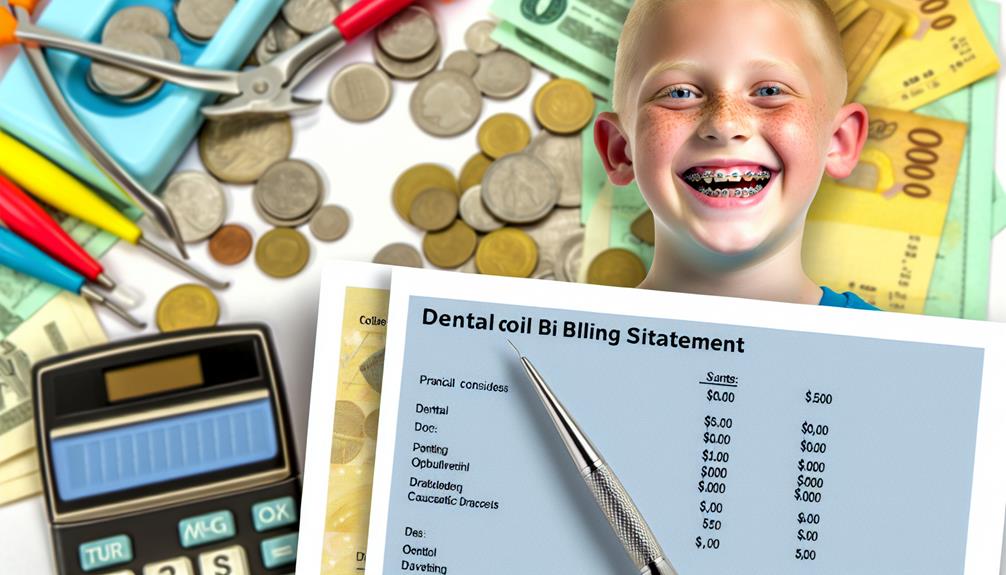Dental insurance often covers a portion of orthodontic care, including braces, but the extent of coverage can vary widely by policy. Most plans provide benefits ranging from 25% to 50% of the treatment cost. Factors influencing coverage include the type of plan, age restrictions, and specific exclusions. It's essential to review the details of your insurance to understand any limits and how they apply to your treatment. Additionally, exploring flexible payment plans and Health Savings Accounts can further alleviate costs. Understanding these nuances will empower you to make informed choices about orthodontic care expenses.
Key Takeaways
- Dental insurance typically offers coverage for orthodontic services, with discounts ranging from 25% to 50% depending on the plan.
- Coverage limits and exclusions may apply, often capping reimbursement for orthodontic treatments, especially for adults.
- Employer-sponsored dental plans often include orthodontic benefits, but specifics like waiting periods and maximum limits vary.
- Utilizing in-network providers can reduce costs due to negotiated rates and enhance insurance benefits.
- Flexible Spending Accounts (FSAs) and Health Savings Accounts (HSAs) provide tax advantages for budgeting orthodontic care expenses.
Overview of Orthodontic Costs

Orthodontic care costs can vary considerably based on several factors, making it crucial for patients to understand the financial implications of treatment. The overall expense of orthodontic care generally encompasses the initial consultation, diagnostic records, treatment plans, and ongoing braces maintenance. Factors such as the complexity of the case, the duration of treatment, and the type of orthodontic technology employed all play significant roles in determining the final cost. During this time, navigating emotional challenges is also important, as patients may experience stress about the financial investment involved in their care.
Advanced orthodontic technology can offer more efficient and effective treatment options, such as clear aligners or digital scanning, which may influence the overall price. Additionally, geographic location and the experience level of the orthodontist can further impact costs. Patients should also factor in potential additional expenses, including follow-up visits, retainers, and any necessary adjustments throughout the treatment process.
Understanding these components will help patients make informed decisions about their orthodontic care. It is advisable to discuss financial options with the orthodontic provider, including payment plans and potential insurance coverage, to guarantee that the journey to a healthier smile is both achievable and financially manageable.
Types of Braces Available
Choosing the right type of braces is an important decision in the orthodontic treatment process, as each option comes with its unique advantages and considerations. Stress can impact overall health, including the immune system, which may affect healing and treatment outcomes, so it's vital to manage stress during this time how stress affects health. Traditional metal braces are the most common and are known for their effectiveness in treating a wide range of alignment issues. They consist of metal brackets and wires and are particularly beneficial for complex cases.
For those seeking a more discreet option, clear aligners are an increasingly popular choice. Made from transparent plastic, these aligners are virtually invisible and can be removed for eating and oral hygiene, making them a convenient alternative for many patients.
Another innovative option is lingual braces, which are attached to the back of the teeth, rendering them hidden from view. This choice appeals to individuals who desire effective orthodontic treatment without the aesthetic concerns associated with traditional braces.
Ultimately, the choice between these types of braces should be guided by individual needs, lifestyle, and orthodontic goals. Consulting with an experienced orthodontist can help determine the most suitable option, fostering a sense of belonging as patients commence their journey toward achieving a confident smile.
Factors Influencing Treatment Costs

The cost of orthodontic treatment can vary considerably based on several key factors that influence pricing. Understanding these factors is essential for patients and families seeking effective orthodontic care that fits their budget. Coping with the financial aspects of orthodontics can be overwhelming, much like steering through emotional challenges in times of grief; however, identifying the right support can ease the process. effective strategies for healing
- Treatment Complexity: The severity of the dental issues being addressed plays a significant role in determining costs. More complex cases may require advanced techniques or longer treatment times, directly impacting the overall price.
- Geographic Location: The cost of living and regional demand for orthodontic services can also affect pricing. Urban areas often have higher treatment costs due to increased overhead and competition among providers.
- Type of Appliances Used: The choice between traditional metal braces, ceramic braces, or clear aligners can lead to different price points. Each type has distinct benefits and costs associated with materials and technology.
Understanding Dental Insurance Plans
While steering through the complexities of dental care, understanding dental insurance plans is vital for managing the costs associated with orthodontic treatment. Dental insurance typically offers various policy types, including Preferred Provider Organizations (PPOs), Health Maintenance Organizations (HMOs), and indemnity plans. Each type presents unique structures and benefits, affecting how orthodontic services are covered. Additionally, it's important to recognize that just like mental health services, dental coverage can vary widely, and some plans may have specific requirements or limitations regarding orthodontic care, including who is covered for treatment.
PPOs usually provide more flexibility in choosing providers and may cover a percentage of orthodontic costs after deductibles are met. In contrast, HMOs generally require members to select from a limited network of providers, potentially leading to lower premiums but less choice. Indemnity plans, while allowing for broader provider access, may involve higher out-of-pocket expenses.
It is essential to review the specifics of your dental policy, as coverage exclusions can greatly impact financial responsibility. For instance, some plans may exclude orthodontic treatment altogether or impose age limits. Understanding these nuances will help you navigate the financial landscape of orthodontic care, ensuring you make informed decisions that align with your needs and budget.
Coverage for Orthodontic Services

Understanding the nuances of dental insurance plans directly influences the level of coverage available for orthodontic services. Many plans offer varying degrees of support, often dictated by specific coverage limits and potential orthodontic exclusions that can impact out-of-pocket expenses. Additionally, exploring stress-free job ideas can provide retirees with options to offset the costs associated with orthodontic care.
When evaluating a dental insurance policy for orthodontic care, consider the following:
- Coverage Limits: Many plans impose caps on the amount they will reimburse for orthodontic treatments. This can greatly affect financial planning for braces.
- Orthodontic Exclusions: Some insurance policies may exclude certain types of orthodontic treatments or conditions, which can lead to unexpected costs.
- Age Restrictions: Certain policies may only cover orthodontic services for children and adolescents, often excluding adult treatment from their plans.
Understanding these elements is essential for individuals seeking orthodontic care. It is advisable to review the specifics of your insurance coverage carefully, as this will help you make informed decisions regarding treatment options and associated costs. By being proactive and informed, you can navigate the complexities of dental insurance and guarantee your family receives the orthodontic care they deserve.
Typical Insurance Discounts for Braces
Steering through the landscape of insurance discounts for braces can greatly affect the overall cost of orthodontic treatment. Most dental insurance plans offer some level of coverage for orthodontic services, typically ranging from 25% to 50% of the total treatment cost. Understanding these discounts is vital for families traversing the financial implications of braces.
Employer-sponsored benefits often include orthodontic coverage as part of their dental plans. However, the extent of this coverage can vary considerably based on the specific policy. It's essential for policyholders to familiarize themselves with their plan details, including waiting periods, maximum coverage limits, and eligible treatment types.
Employing effective insurance negotiation strategies can further enhance the potential discounts. Engaging with insurance representatives to clarify coverage specifics or exploring supplemental insurance options may yield additional savings. Some orthodontic practices also offer payment plans or financing options that can align with insurance benefits, making treatment more accessible.
Out-of-Pocket Expenses Explained

Many families may not realize the extent of out-of-pocket expenses associated with orthodontic care. While dental insurance may cover a portion of the costs, families often face additional expenditures that can greatly impact their budgets. Understanding these expenses is essential for effective financial planning.
Out-of-pocket costs can include:
- Initial consultation fees for orthodontic evaluations.
- Retainers and follow-up visits after braces removal, which are vital for maintaining teeth alignment.
- Unforeseen expenses, such as emergency repairs for broken braces or additional treatments to address complications.
To navigate these costs, families should consider implementing effective budgeting strategies. Creating a detailed budget that accounts for both expected and unforeseen orthodontic expenses can help alleviate financial stress. Additionally, exploring flexible spending accounts (FSAs) or health savings accounts (HSAs) may provide tax advantages, further easing the financial burden.
Ultimately, being proactive about out-of-pocket expenses allows families to make informed decisions about orthodontic care, ensuring that they can achieve the desired results without compromising financial stability. Understanding these costs fosters a sense of belonging within the orthodontic community, as families share resources and experiences.
Payment Plans and Financing Options
When considering orthodontic care, understanding payment plans and financing options is essential for managing costs effectively. Many orthodontic practices offer flexible payment plans that allow patients to spread the expense over time, making treatment more accessible. Additionally, low-interest financing options can further ease the financial burden, enabling patients to invest in their oral health without compromising their budget.
Flexible Payment Plans
How can patients manage the financial commitment of orthodontic care without undue stress? Flexible payment plans can provide a viable solution, allowing patients to receive the necessary treatment while accommodating their financial situations. These plans often offer payment flexibility, enabling patients to spread the costs over a designated period, thereby reducing the immediate financial burden.
Consider the following budgeting strategies when evaluating flexible payment plans:
- Monthly Installments: Break down the total cost into manageable monthly payments that fit your budget.
- No Interest Options: Some orthodontic practices offer plans with no added interest, making it easier to pay over time without extra fees.
- Deposit Reductions: Look for practices that allow lower initial deposits, easing entry into treatment without substantial upfront costs.
Low-Interest Financing Options
For patients seeking to manage orthodontic care costs effectively, low-interest financing options offer an attractive alternative to traditional payment plans. These financing plans provide a pathway to achieving the smile you desire without the burden of high upfront costs. Many orthodontic practices partner with financial institutions to offer tailored payment solutions that can accommodate various budgets.
Low-interest financing options typically feature manageable monthly payments, allowing patients to spread the cost of treatment over time. This makes orthodontic care more accessible and aligns well with family budgets. Additionally, these plans often come with minimal or no down payment requirements, making them an appealing choice for those who may be concerned about immediate financial impacts.
When exploring affordable options, patients should inquire about the specific terms of financing plans, including interest rates, payment schedules, and any potential fees. Understanding these details can help guarantee that you select the financing option that best fits your financial situation. Ultimately, low-interest financing provides a practical solution for families and individuals alike, empowering them to invest in their oral health without compromising their financial stability.
Maximizing Your Insurance Benefits

To effectively maximize your insurance benefits for orthodontic care, it is essential to understand your coverage limits, including the specific allowances for treatments and services. Utilizing in-network providers can greatly enhance your financial advantages, as they often offer reduced rates compared to out-of-network options. Additionally, leveraging Flexible Spending Accounts (FSAs) can provide a strategic way to allocate pre-tax funds towards orthodontic expenses, further optimizing your overall insurance use.
Understanding Insurance Coverage Limits
Maneuvering the complexities of orthodontic insurance coverage can greatly impact the overall cost of treatment, making it vital to understand the specific limits and benefits associated with your plan. Various coverage types can dictate how much your insurance will contribute towards braces and other orthodontic procedures. Familiarizing yourself with these options allows you to navigate potential policy limitations effectively.
Key factors to bear in mind include:
- Lifetime Maximums: Many plans have a cap on the total benefits available for orthodontic treatment, which can limit your reimbursement.
- Age Restrictions: Some policies may only cover treatment for children or teenagers, leaving adults to shoulder the full cost.
- Co-pays and Deductibles: Understanding your out-of-pocket expenses is essential, as these amounts can vary greatly depending on your specific policy.
In-Network Provider Advantages
Choosing an in-network orthodontic provider can greatly enhance your ability to maximize insurance benefits and minimize out-of-pocket expenses. In-network providers have established relationships with your dental insurance company, allowing them to offer network benefits that can considerably reduce the cost of orthodontic treatments such as braces.
When you select an in-network provider, you typically benefit from negotiated rates that lower your overall financial burden. These providers have a thorough understanding of your insurance plan's coverage parameters, ensuring that you receive the most appropriate care without unexpected costs. Additionally, in-network orthodontists are often well-versed in the specific procedures covered by your plan, facilitating streamlined treatment plans that align with your insurance benefits.
Moreover, engaging with in-network professionals fosters a sense of community and trust, as these providers are committed to maintaining their provider relationships with insurance companies. This alignment can lead to more extensive care, as the orthodontist is likely to focus on optimizing your treatment within the framework of your coverage. Ultimately, choosing an in-network orthodontic provider is a strategic decision that can make a substantial difference in your orthodontic care experience and financial outcome.
Flexible Spending Accounts Usage
Utilizing a Flexible Spending Account (FSA) can considerably enhance your ability to manage orthodontic care costs while maximizing your insurance benefits. By setting aside pre-tax income through FSA contributions, you can effectively reduce your overall expenses related to braces and other orthodontic treatments. This strategic financial tool allows you to allocate funds specifically for eligible expenses, ensuring you get the most out of your insurance coverage.
Consider the following benefits of using an FSA for orthodontic care:
- Tax Savings: Contributions to your FSA are made pre-tax, which lowers your taxable income.
- Budgeting Assistance: FSAs help you plan for upcoming orthodontic expenses, allowing you to pay for treatments as they arise.
- Enhanced Coverage: By using FSA funds for out-of-pocket costs, you can maximize the benefits from your dental insurance plan.
Alternatives to Traditional Insurance
Exploring alternatives to traditional insurance can provide individuals with more flexible and accessible options for managing orthodontic care costs. These alternatives can often alleviate the financial burden of braces while ensuring that patients receive the necessary treatment.
One viable option is to utilize Health Savings Accounts (HSAs), which allow individuals to save pre-tax dollars for medical expenses, including orthodontic care. Additionally, many orthodontic practices offer alternative financing plans, enabling patients to break down the total cost into manageable monthly payments, making treatment more accessible.
Here's a comparison of some alternatives:
| Alternative Option | Description |
|---|---|
| Health Savings Accounts | Tax-advantaged accounts for medical expenses. |
| Flexible Payment Plans | Monthly payment options offered by providers. |
| Personal Loans | Financing through banks or credit unions. |
| Dental Discount Plans | Membership plans offering reduced fees for services. |
Utilizing these alternatives can empower patients to seek the orthodontic care they need without being hindered by traditional insurance limitations. By exploring these options, individuals can achieve healthy, beautiful smiles while maintaining financial stability.
Frequently Asked Questions
How Long Does Treatment With Braces Usually Take?
The duration of treatment with braces typically ranges from 18 months to three years. However, this braces duration can vary considerably based on several treatment factors, including the complexity of the dental issues being addressed, the type of braces used, and the patient's adherence to the orthodontist's recommendations. Regular appointments and proper oral hygiene also play critical roles in ensuring an effective and timely orthodontic treatment outcome.
Are Braces Covered for Adults as Well as Children?
Braces can indeed be covered for adults as well as children, depending on the dental insurance plan. Many policies include adult coverage for orthodontic treatments, recognizing the increasing number of adults seeking braces. However, it is crucial to review the specific terms of your insurance policy, as coverage for children's braces may differ considerably. Understanding these distinctions guarantees that individuals and families are well-informed about their orthodontic care options and potential financial responsibilities.
What Happens if I Change Insurance During Treatment?
Changing insurance during orthodontic treatment can lead to various implications. An insurance shift may result in coverage differences, potentially affecting the benefits available for ongoing care. It is essential to review the new policy's details to understand any limitations or exclusions related to orthodontic services. Consulting with both the orthodontist and the new insurance provider will help clarify coverage specifics, ensuring a seamless continuation of treatment and minimizing any unexpected financial burdens.
Can I Use FSA or HSA Funds for Braces?
Funds from Flexible Spending Accounts (FSA) and Health Savings Accounts (HSA) can be utilized for orthodontic expenses, including braces, provided they meet FSA eligibility criteria and are deemed medically necessary. However, HSA limitations may apply based on individual circumstances. It is essential to consult with your plan administrator to guarantee compliance and to understand the specific conditions under which these funds can be accessed for orthodontic treatment, thereby maximizing your financial resources.
Are There Any Age Restrictions for Orthodontic Insurance Coverage?
When considering orthodontic insurance coverage, age eligibility can vary markedly among providers. Many plans do not impose strict age restrictions, allowing coverage for both children and adults. However, it is essential to review the specific policy, as some may have coverage limits tied to age or the onset of treatment. Understanding these nuances guarantees that individuals can make informed decisions regarding their orthodontic care, maximizing their insurance benefits effectively.





